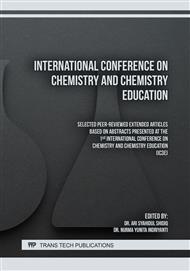[1]
Andre, Manfred Smieschek, Stollenwerk Patrick J, Thorsten Orlikowsky, And Mark Schoberer. "Evaluating Hand Disinfection with Alcohol-Based Hand Sanitizers Using Thermal Imaging." In 2nd Workshop on Fail Safety in Medical Cyber-Physical Systems, Wien 2016 Evaluating, (2016). 174–81.
Google Scholar
[2]
Bedford, Juliet, Delia Enria, Johan Giesecke, David L. Heymann, Chikwe Ihekweazu, Gary Kobinger, H. Clifford Lane et al. "COVID-19: towards controlling of a pandemic." The lancet 395, no. 10229(2020): 1015-1018
DOI: 10.1016/S0140-6736(20)30673-5
Google Scholar
[3]
She, Jun, Jinjun Jiang, Ling Ye, Lijuan Hu, Chunxue Bai, and Yuanlin Song. "2019 novel coronavirus of pneumonia in Wuhan, China: emerging attack and management strategies." Clinical and translational medicine 9, no. 1 (2020): 1-7
DOI: 10.1186/s40169-020-00271-z
Google Scholar
[4]
Jing, Jane Lee Jia, Thong Pei Yi, Rajendran JC Bose, Jason R. McCarthy, Nagendran Tharmalingam, and Thiagarajan Madheswaran. "Hand sanitizers: a review on formulation aspects, adverse effects, and regulations." International journal of environmental research and public health 17, no. 9 (2020): 3326.
DOI: 10.3390/ijerph17093326
Google Scholar
[5]
Samson, Robert A., Jos Houbraken, Richard C. Summerbell, Brian Flannigan, and J. David Miller. "Common and important species of fungi and actinomycetes in indoor environments." Microorganisms in home and indoor work environments: diversity, health impacts, investigation and control (2002): 285-473
DOI: 10.1007/978-3-319-29137-6_15
Google Scholar
[6]
Abarca, M. L., M. R. Bragulat, G. Castella, and FJ201698 Cabanes. "Ochratoxin A production by strains of Aspergillus niger var. niger." Applied and environmental microbiology 60, no. 7 (1994): 2650-2652
DOI: 10.1128/aem.60.7.2650-2652.1994
Google Scholar
[7]
Xavier, Marilia B., Marcia M. R. Ferreira, Juarez A. S. Quaresma, and Arival C. de Brito. "Hand Sanitizer Alert." Emerging Infectious Diseases. 12(3) (2006): 527–29
DOI: 10.32734/abdimastalenta.v5i2.5070
Google Scholar
[8]
Dixit, Alok, Pinki Pandey, R. Mahajan, and D. C. Dhasmana. "Alcohol based hand sanitizers: Assurance and apprehensions revisited." Res. J. Pharm. Biol. Chem. Sci 5, no. 1 (2014): 558-563
Google Scholar
[9]
Narang, Aryan. "Comparing the effectiveness of various hand-sanitizers against E. coli." International Journal of Pharmaceutical Science and Research ISSN: 3, no. 4 (2018): 16-18.
Google Scholar
[10]
Adu, Risna Erni Yati, Ite Morina Yostianti Tnunay, Didi Prasetyo Benu, Florian MPR Makin, and Dicky Hanas. "Education of making natural hand sanitizers to the community of Haulasi Village, North Central Timor Regency." Abdimas Talenta: Journal of Community Service 5, no. 2 (2020): 144-149
DOI: 10.32734/abdimastalenta.v5i2.4327
Google Scholar
[11]
Acharya, Shri Balakrishna, Saradindu Ghosh, Giriraj Yadav, Kavita Sharma, Sirsendu Ghosh, and Sushil Joshi. "Formulation, evaluation and antibacterial efficiency of water-based herbal hand sanitizer gel." bioRxiv (2018): 373928
DOI: 10.1101/373928
Google Scholar
[12]
Ghasemian, M. "Journal of Fisheries & Eucalyptus Camaldulensis Extract as a Preventive to the Vibriosis in Western White Shrimp (Litopenaeus Vannamei ) in Bushehr Province." Journal of Fisheries & Livestock Production 6(2) (2018): 2–6
DOI: 10.1515/tjb-2018-0438
Google Scholar
[13]
Hayat, Aliya, and Fizza Munnawar. "Antibacterial effectiveness of commercially available hand sanitizers." Int J Biol Biotech 13, no. 3 (2016): 427-431.
Google Scholar
[14]
Álvarez-Román R, Silva-Flores PG, Galindo-Rodríguez SA, et al. Moisturizing and antioxidant evaluation of Moringa oleifera leaf extract in topical formulations by biophysical techniques. South African J Bot, 2020; 129: 404–411.
DOI: 10.1016/j.sajb.2019.10.011
Google Scholar
[15]
He, Feng, Yu Deng, and Weina Li. "Coronavirus disease 2019: What we know?" Journal of medical virology 92, no. 7 (2020): 719-725
DOI: 10.1002/jmv.25766
Google Scholar
[16]
Praveen, D., Ranadheer Chowdary Puvvada, and Vijey Aanandhi. "Janus kinase inhibitor baricitinib is not an ideal option for management of COVID-19." International journal of antimicrobial agents 55, no. 5 (2020): 105967
DOI: 10.1016/j.ijantimicag.2020.105967
Google Scholar
[17]
Cheng, Qiaofen, and Da-Wen Sun. "Factors affecting the water holding capacity of red meat products: A review of recent research advances." Critical reviews in food science and nutrition 48, no. 2 (2008): 137-159
DOI: 10.1080/10408390601177647
Google Scholar
[18]
da Silva, A. L. D., Martín-Martínez, J. M., & Bordado, J. C. M. Influence of the free isocyanate content in the adhesive properties of reactive trifunctional polyether urethane quasi-prepolymers. International journal of adhesion and adhesives, 26(5) (2006) 355-362
DOI: 10.1016/j.ijadhadh.2005.06.001
Google Scholar
[19]
Nurdianti, L. (2020). Testing Anti-Bacterial Activity of The Preparation Of Harumanis Mangga Leaves (Mangifera Indica, L) Ethanol Extract Mouthwash Against Streeptococcus Mutans Caused Dental Carries. Journal of Pharmacopolium, 3 (2020) 1
Google Scholar
[20]
Nurjanah, S., Zain, S., & Komalasari, E. Study of Flower Balance Using Adsorbent to the Yield and Quality of Frangipani Flower Essential Oil (Plumeria obtusa) with Enfleuration Method. Indonesian Journal of Essential Oil, 2(1), (2017) 1–9
DOI: 10.21776/ub.ijeo.2017.002.01.01
Google Scholar
[21]
Arifin, H., Anggraini, N., Handayani, D., & Rasyid, R. Standarisasi ekstrak etanol daun Eugenia cumini Merr. J. Sains Tek. Far, 2006;11(2), 88-93.
Google Scholar
[22]
Ueda, Clarence T., Vinod P. Shah, Kris Derdzinski, Gary Ewing, Gordon Flynn, Howard Maibach, Margareth Marques et al. "Topical and transdermal drug products." In Pharmacopeial forum, vol. 35, no. 3, (2009) pp.750-764
DOI: 10.14227/DT170410P12
Google Scholar
[23]
Anil, M. H., S. Love, C. R. Helps, and D. A. Harbour. "Potential for carcass contamination with brain tissue following stunning and slaughter in cattle and sheep." Food Control 13, no. 6-7 (2002): 431-436
DOI: 10.1016/S0956-7135(01)00055-X
Google Scholar
[24]
Rowe, R. C., Sheskey, P. J. & Quin, M. E., 2009. Handbook of Pharmaceutical Excipients. Sixth ed. UK: Pharmaceutical Press.
Google Scholar
[25]
Ahmed, J., Shivhare, U. S. dan Raghavan, G. S. Color Degradation Kinetics and Rheological Characteristics of Puree. Transactions of the ASAE. American Society of Agricultural Engineers. Jurnal Food Vol. 44(1).2001
DOI: 10.13031/2013.2293
Google Scholar
[26]
Wani, RR, Patil, M.P., Dhurjad, P, Chaudhari, C.A., Kshirsagar, S.J., 2015, Microemulsion Based Gel: A Novel Approach in Delivery of Hydrophobic Drugs, International Journal for Pharmaceutical Research Scholars, 5(4), 597-604.
Google Scholar
[27]
Sapers, Gerald M. Washing and sanitizing raw materials for minimally processed fruit and vegetable products. CRC Press: Boca Raton, FL, London, New York, Washington, DC, 2003
DOI: 10.1201/9781420031850.ch11
Google Scholar



